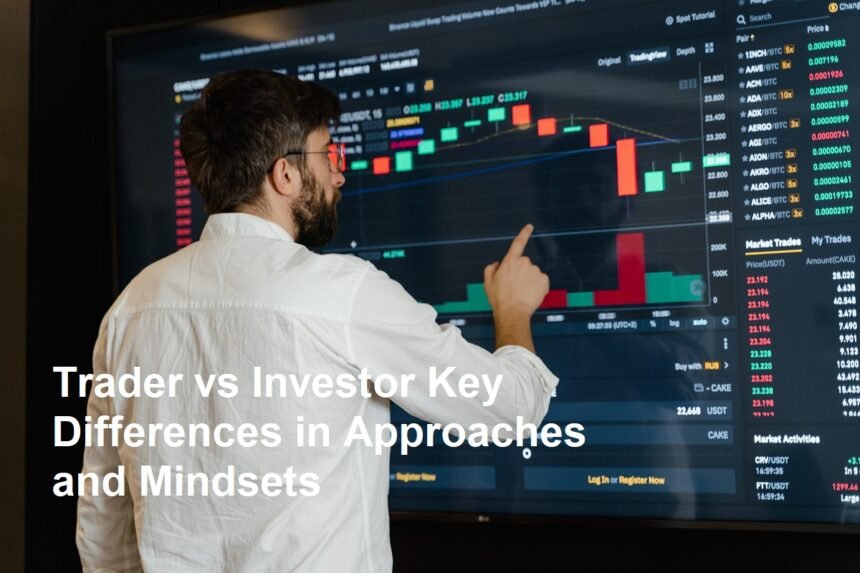Introduction
When I first stepped into the fascinating world of financial markets, I often heard passionate debates about which is better: trading or investing. With so many approaches out there, it’s crucial to understand that being a trader and being an investor aren’t simply two sides of the same coin. Let me take you through a deep dive to understand their key differences.
Understanding the Basics
Let’s begin with the basics. A trader is someone who buys and sells assets such as stocks, currencies, or commodities frequently, aiming to profit from short-term price changes. Investors, on the other hand, typically buy assets with the goal of holding them for the long run, believing they’ll increase in value over years—even decades.
Time Horizon
This is the easiest distinction to spot. Traders think in minutes, hours, or days; most trades are held for a very short term. For example, day traders may open and close multiple positions within a single trading session. Investors, in contrast, happily hold their assets for years, letting the magic of compounding and the company’s growth build their wealth.
It didn’t take me long to realize how patience shapes the investor’s journey, while speed and timing rule the trader’s world.
Risk and Reward Approach
Traders are risk-takers, often facing higher levels of stress because rapid market swings can mean quick profits—or steep losses. Their constant monitoring of charts and news can make trading exhilarating but also exhausting. Investors, with their longer timeframes, usually take on less day-to-day risk. They often ride out short-term volatility, banking on steady, long-term growth.
Still, I’d say that both styles require nerves of steel—just in very different ways!
Decision-Making Style
If someone asked me about the mindset differences, I’d explain it through decision-making. Traders rely more heavily on technical analysis, using price charts, indicators, and patterns to find entry and exit points. Investors, meanwhile, dive deep into fundamental analysis—they’ll study annual reports, analyze industries, and consider a company’s economic health.
For a trader, the headline “Tech Stocks Surge in One Day Rally” is a call to action. For an investor, it’s a blip on the long-term journey. I personally find the contrast in how each reads market news fascinating!
Frequency and Volume of Transactions
Traders are the market’s most active participants. Multiple trades a day are not uncommon, depending on their strategy (scalping, day trading, swing trading, etc). Investors, though, make relatively few transactions—sometimes only adjusting their portfolio a few times a year or even less.
Tools and Resources
Trading platforms burst with real-time data, charting software, fast order execution tools, and constant price streams—these are a trader’s playground. Investors, on the other hand, might spend more time poring over annual reports, macroeconomic data, industry analysis, or company management interviews.
Cost Structure
Trading frequently racks up transaction costs. Commissions, spreads, and slippage can erode profits if not managed carefully. Investors, thanks to their low turnover, pay less in transaction fees—although there’s always the question of opportunity cost when assets just aren’t performing.
Discipline and Psychological Demands
Both roles require discipline, but in different forms. Traders must stick to clear plans, manage emotions, and resist impulsive trades. Investors need the fortitude to hold through market downturns and the patience to let their ideas play out, sometimes over decades.
I’ve often imagined the contrasting inner dialogues: a trader fighting the urge to chase a fast-moving stock, an investor reminding themselves not to panic-sell in a crisis headline.
Which One Is Right for You?
Ask yourself: Do you love the thrill of frequent action and analyzing short-term trends? Or does the idea of watching your wealth grow steadily over time sound more appealing? There’s no right or wrong answer, and sometimes the best approach lies in a blend of both—trading with a portion of your funds while investing the rest.
Final Thoughts
Understanding the essential differences between traders and investors isn’t just an academic debate—it shapes how you set financial goals, build your strategy, and cope with inevitable ups and downs. Whether you’re making lightning-fast trades or calmly watching your investments mature, remember: the most successful market participants are those who truly know themselves—and stick to a plan that fits their temperament and objectives.











